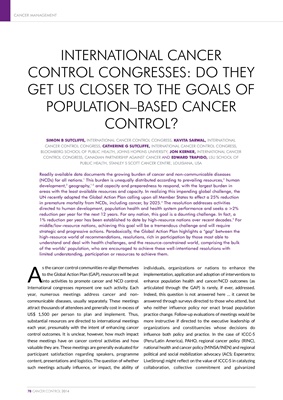
CANCER MANAGEMENT
CANCER CONTROL 2014 79
implementation of cancer /NCD control interventions.
Insights into the probability that a meeting will influence
population health and illness outcomes can be gleaned by
answering four questions:
‰ Why is the meeting being held? What is its purpose?
International meetings are held for different purposes:
- To present "state-of-the-art" disease management with a
focus on the disease (cancer/cancer type) and the
interventions to modify the disease impact. Examples
include breast, lymphoma and lung meetings.
- To present "state-of the-art" modality management with
a focus on the modality, the discipline(s) of practice, and
advances in science and technology. Examples include
American Society of Clinical Oncology (ASCO) and the
American Society for Therapeutic Radiology and
Oncology (ASTRO).
- To raise awareness, profile and advocacy for control of
the disease through an organization, society or forum.
Examples include American Cancer Society, LiveStrong,
Union for International Cancer Control (UICC), World
Cancer Forum and the World Cancer Leaders Summit.
- To implement plans and solutions for reducing the
burden of the disease at a population level. Examples
include the ICCC.
The purpose of the conference will determine the
constituencies who will be present (the attendees and their
relationships), the context for consideration ("discovery"
science/scientific evidence-base; contextual adaptation;
relevance and translation of science to policy and practice;
science and technology development), and the funding
support. Revenue to support the meeting derives from
registration fees, organization or society membership
contributions, industry or governmental sponsorship, private
sector contributions and charitable and/or Foundation
support (Table 1). Funding support, other than registration, is
generally higher when the purposes of the meeting and the
interests of funders are aligned.
An appropriate way to define the purpose of a conference
is through a "logic model" that addresses the purpose; goals,
objectives and key directions; measures of process ("how"),
and measures of output and outcome, and impact. This
approach to conference design aligns purpose, product,
outcome and evaluation and, additionally, identifies where
the most appropriate sources of conference revenue are
likely to come from for specific programme components.
‰ Who is intended to derive the most benefit from the
meeting? There are many constituencies who may benefit
individually and/or collectively from a cancer control
meeting:
- Individual practitioners and/or their professional
organizations/societies who represent scientific
"discovery", clinical advance or application of measures
to advance disease control.
- High, middle or low-resource constituencies who face
the issue of disease control from different contexts,
resources and capacities.
- Global and regional individuals/groups who stand to
benefit through shared information, learning,
mentorship and support to develop or enhance
population-based cancer control.
The constituencies most intended to benefit should
influence the "content" (the programme, the focus and the
balance of interventional activities), the "context" (adaptation
of content to context, cultures, priorities, resources, capacity,
preparedness and resolve) and the breadth of participation
and collaboration, both interdisciplinary and intersectoral,
that is likely to ensue and be required.
‰ Where is the meeting being held? Where the meeting is
located will have a bearing on the probability that it will
achieve its purpose. The possibilities include:
- A jurisdiction of global political awareness and social
advocacy.
- A jurisdiction of the major financial
contributors/sponsors.
- The nations/countries who are primarily intended to
benefit from conference participation.
- A location of convenience for travel or prices.
Meetings held in jurisdictions of high global political
awareness and social advocacy, such as Geneva, Washington
DC, or New York, are likely to attract delegates from highresource regions, or those from low- and middle-resource
countries whose attendance is fully sponsored (registration
fees, travel, accommodation, and hospitality costs). Delegates
from low- and middle-resource nations are least likely to
benefit from presentations that address cancer control
programmes in high-resource settings. Accordingly, the
location of the conference is likely to have a profound
influence upon participant attendance from low- and middleresource settings, and also upon the content, context,
and
relevance to practice within low- and middle-resource
settings. In principle, the location of the meeting has a direct
bearing upon both the probability of attendance, the
relevance of the content of the meeting on the intended